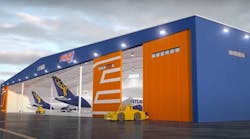A quarter of a century ago, the credibility of composite repair depended on the skill of individual craftsmen. It still does.
Despite advances in automation, despite studies aimed at standardizing repairs, the essence of aircraft composite repair is still “some science combined with a lot of art,” contends Basil Barimo, executive vice president of NORDAM’s repair division.
The scope of that artistic science has steadily woven its way into the fiber of flying machines. In 1989 composites clung to commercial aircraft almost solely as secondary structure: gear doors, radomes, wing-to-body fairings. By then, high-performance European sailplanes had already begun to sport carbon fiber spars, skins, and fuselages. “All the structures went composite,” says Michael J. Hoke, president and owner of Abaris Training Resources.
As sailplane composite use soared, the military migrated to F/A-18 composite wing-skins and tail surfaces. The AV-8B Harrier donned an all-carbon fiber wing in the 1980s. Sportplanes and warplanes strutted their carbon fiber stuff, as commercial aircraft took baby steps.
Spurred by fuel costs and the command to cut weight, “We’ve seen composites really take over,” says Barimo. Boeing’s all-new 787 and Airbus’ A350 stand out. So too the 777X. It will have an all-composite wing.
Composite repair: theory and practice
On “the theoretical side” composite repair is “considerably advanced from where it was … when I was a structures engineer,” says David A. Marcontell. “There’s a whole lot more ability to repair,” contends the president and COO of TeamSAI. That said, the MRO consultant is not convinced repair practices and expertise, “have made it very far into the actual MRO industry.”
Marcontell doesn’t pretend to be a composites expert. But he possesses a keen eye for industry capabilities. While he believes “Boeing and Airbus have done a fabulous job of designing repair methodologies, the actual application of those repairs is limited to a very, very few companies” – and still fewer folks within those companies.
Certainly the ability to apply new repair technologies per se has improved over the past two-and-a-half decades. Tools are more sophisticated, more computerized. “We’ve got better techniques for monitoring temperature across the repair surface,” says Mike Hoke, “documenting and recording [it] on a minute-by-minute basis as the repair’s being cured.”
25 years ago, technicians arrayed heat blankets and vacuum bags atop the composite area to be cured, depending on a thermocouple to record how hot things got. Problem is the thermocouple was singularly site-specific.” You didn’t know if 6 to 8 inches away it was running too cold, too hot or whatever,” says Hoke.
Today, a cadre of thermocouples cover over the repair surface, “so you can measure the temperature at the edges of the repair, the middle of the repair and all over,” he says. That makes an enormous difference if the structure is underlain by nettlesome heat sinks.
Modern composite structure often integrates stiffeners and skin. Those stiffeners, secreted below the surface, act as radiators. Beneath that surface “the repair area will be colder over that stiffener.” The result is a cold stripe perhaps every 6 inches or so. Hoke says technicians couldn’t discern that before. “Now, [they] can tell what’s happening and monitor and control it.”
Bottom line says the Abaris chief: "The industry has made real progress in repair quality control, accuracy, and uniformity. But for all those advances, composite repair remains awfully “dependent on the skills and integrity of the technician that’s physically going the work.”
This is the domain of the composite artisan, the person’s whose “skill set … may be a little bit more involved than if they were just working on metallic structures,” says Lamia Salah, co-principal investigator with the National Institute for Aviation Research. She and principal investigator Dr. John Tomblin are conducting the Commercial Aircraft Composite Repair Committee’s Composite Bonded Investigation at Wichita State University. Salah says one aim is to “take [composite] repair standards developed by the CACRC, give them to mechanics, let them perform repairs and basically see whether these standards are robust enough.” Phase one of the study should be complete by mid-2014.
This search for more stalwart standards takes on added importance with fuselages, wings and such. So sophisticated – and far-between – are these fixes that Dave Marcontell envisions the rise of mobile specialty companies that “do the repair and then leave.”
It might make scant sense for an MRO or carrier to train up technicians on repairs they rarely employ. Consider, NORDAM’s Basil Barimo says fixing sophisticated monolithic composite structures can cost as much as three times more to repair than older composites or present metallics.
Perhaps this is where the future does lie – with teams of mobile, high-tech equipped composite artisans. Barimo believes true standardization will “remain the Holy Grail” a while longer.
Jerome Greer Chandler is a two-time winner in the Aerospace Journalist of the Year' competition's Best Maintenance Submission category; he won in 2000 and 2008. His best-seller 'Fire and Rain' chronicles the wind shear crash of Delta Flight 191 at DFW. Chandler's passion for aviation safety is more than professional. It's personal. Two of his relatives have perished on commercial airliners, one of them in the infamous Braniff Electra crash of 1959.



